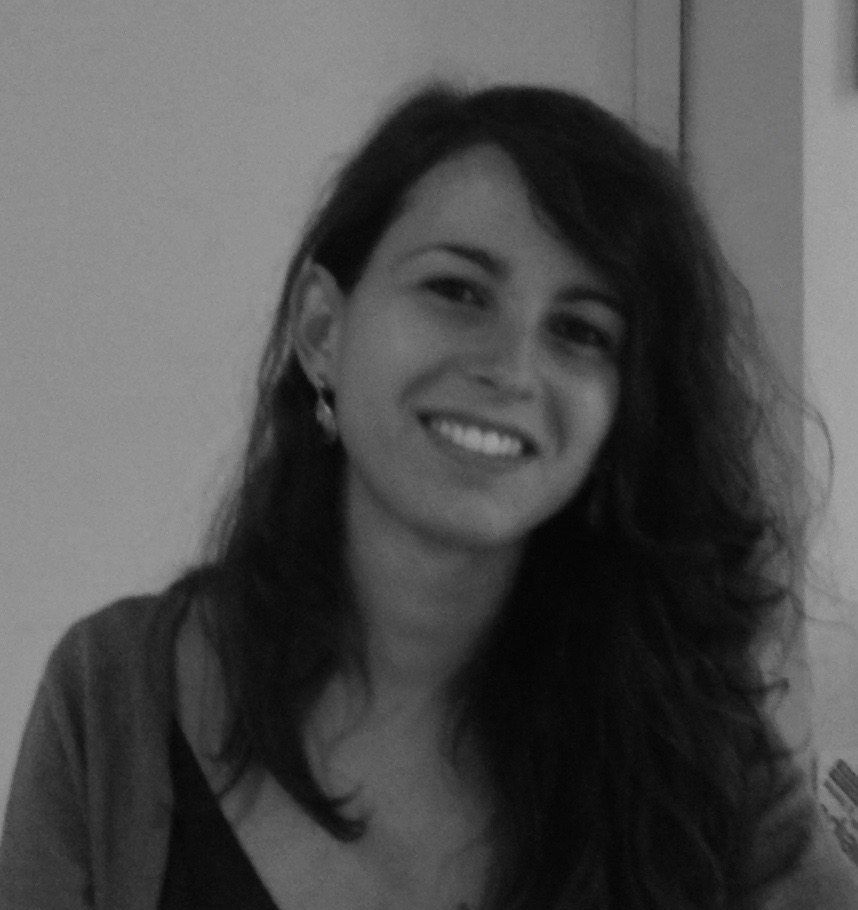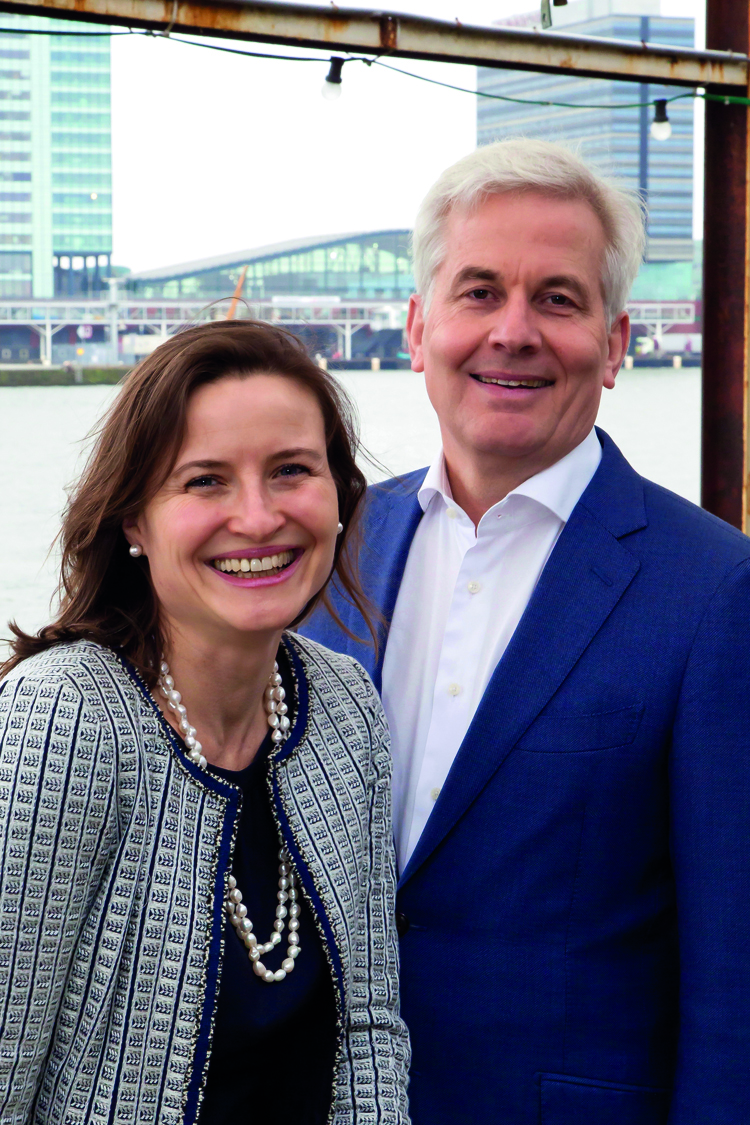 |
|
Photo by Mirjam Verschoor
|
Two Germans in the kingdom of the Netherlands. A great big slice of the Dutch circular economy is based on the vision of Thomas Rau and Sabine Oberhuber, who, for decades, have made the Netherlands their home. Rau and Oberhuber, the former an architect with a background in business strategy, and the latter a business strategist, founded Turntoo in their adoptive nation. With their new forms of architecture, innovative concepts, circular products and services, they aim to facilitate the man-nature equilibrium as well as our temporary presence on the planet. “We are the Earth’s guests,” they say.
So Renewable Matter interviewed them in their office in the north of Amsterdam – a bright open space, where the position of the desks does not reveal much about the chain of command. There is not any inaccessible office and Rau and Oberhuber are immediately visible to anyone coming in. We met them about one month after the launch of the Madaster Foundation, which aims to eliminate construction waste across the world, by means of an online registry for Material Passports, which will catalogue all materials currently present in buildings. Thomas Rau and Sabine Oberhuber have also recently published the book Materials Matter, currently only available in Dutch.
Why do materials need a passport?
Rau: “Waste is made up of materials with no identity. To prevent materials losing their identity and becoming waste they need a passport, which allows for their cataloguing with the objective of preservation, reuse and also saving on costs, whereby reducing and, finally, eliminating waste. Let us take the gold case: some of the gold in circulation today could derive from Roman times. Historically, gold does not become waste as everyone knows it is a ‘limited edition’ material. But today, gold is used in nano-quantities in for example smartphones in a way it cannot be recuperated. These are minimum quantities of gold if we look at the individual pieces, but, if we consider the total, the loss is considerable. A ton of smartphones contains more gold than a ton of gold-ore. Material passports will allow us to know exactly where all the materials are located, including gold, and keep them in circulation.”
Oberhuber: “Since we started producing electronic devices, gold has begun to disappear and we are not talking about little amounts if we look at the total. The Netherlands, for example, lost a quantity of gold equal to €27 million in 2014, in just one year.”
What can we do with the materials platform realised by Madaster Foundation?
Rau: “Our objective is to create a global inventory of the materials available. We are convinced that we have to inventorise and manage the resources in the system. The Madaster platform will be a public body comparable to the Cadastre. Nobody owns it. Everyone can use it. There will be an access fee. Then everyone can make use of the information. For individual real-estate owners it will allow, for example, for recording one’s own building and, as a service, knowing the value of the materials present in the structure every year. When buildings are deconstructed they become a mine of materials, demolition materials are no longer turned into waste and therefore wasted. But with Madaster you will also be able to see how a building was built, which provides important information on how easily material can be extracted. We believe it will lead to a completely different way to design buildings – with the deconstruction in mind. This is at least how the RAU studio designs buildings now.”
How can old buildings be renovated?
Rau: “The first question is how do we reinvent buildings while preserving their identity. This does not mean preserving everything, but analysing in order to understand which buildings are rich enough – both in terms of identity and history and in terms of materials – to be preserved. Buildings, which must be demolished are treasure troves of materials, they can serve for new constructions, but also for redeveloping those that we want to preserve because they were being built in the same period, hence the same types of materials were used. Today, we know how many buildings need renovating, but we do not know what materials form them – we can close this gap by inventorying the materials with the passport and Madaster.
Oberhuber: “It is important to analyse at what level you can reuse the materials in the building – at buildings level, components level or materials level and look creatively on how to use what is present. In 2015 we did this for the headquarters of Liander, one the first circular buildings worldwide. What we found when we started was a very ugly structure from the 60’s consisting of several buildings scattered over the terrain. We analysed how we could reuse a maximum of what was already there and at the same time create a \'new\' building. The result was a preservation of 90% of all the materials we found, while, at the same time, we created a building which in nothing resembled the one we found.
“We reused the majority of the components and materials of the existing buildings, the existing ceiling plates, the concrete from the parts, which were demolished. We recycled the asphalt from the existing roofs, and converting the existing doors into new furniture, amongst many other things.
“Everything we added was designed with disassembly and reassembly in mind. The metal structure from the roof is designed with the help of a roller coaster construction group, minimalizing its weight, thus reducing the unnecessary use of raw materials and allowing disassembly for later reuse. Everything is documented in a ‘raw material passport’ in order to assure the reuse of all the materials in the future.”
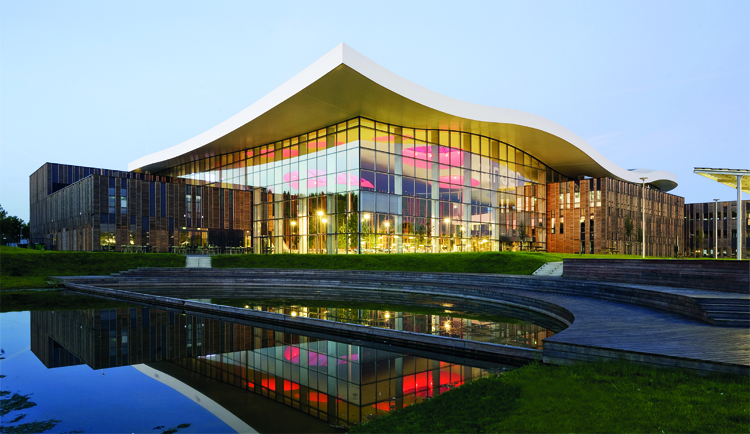 |
|
New Liander building, Dulven.
|
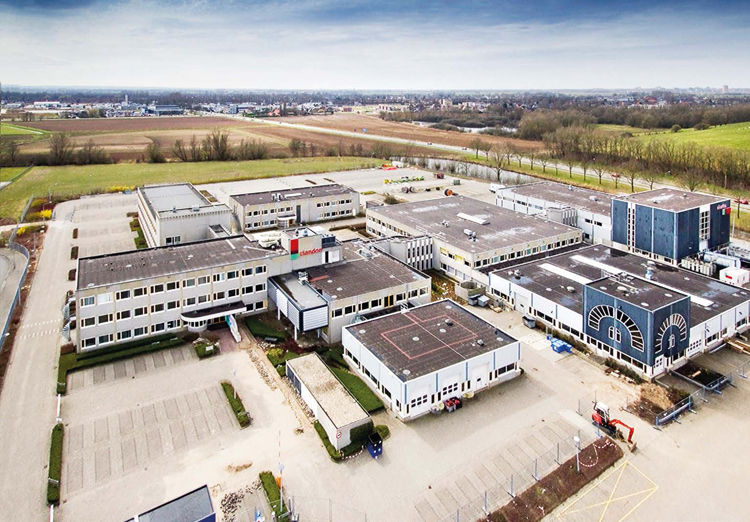 |
|
Old Liander building, Dulven.
|
How can we combine the restructuring and maintenance of old and new buildings with the reduction of energy consumption?
Rau: “I think the focus is not energy – there is not an energy problem, we have enough renewable sources for every site. We are capable of creating energy positive/energy producing buildings for both new and renovation projects. Energy becomes important when we look at the consumption side of the devices used in the building, e.g. installation but also electronic devices, this needs to be taken care of, as the consumption often is unnecessarily high. In that case the ‘product as a service’ concept provides a solution as it allows us to move the energy bill to the producer, which gives him an incentive to provide us with equipment that uses less energy. Through the ‘product as a service’ concept, we can reduce energy demand and move the focus from how much we need to produce to how much we can reduce the energy demand without losing any comforts.”
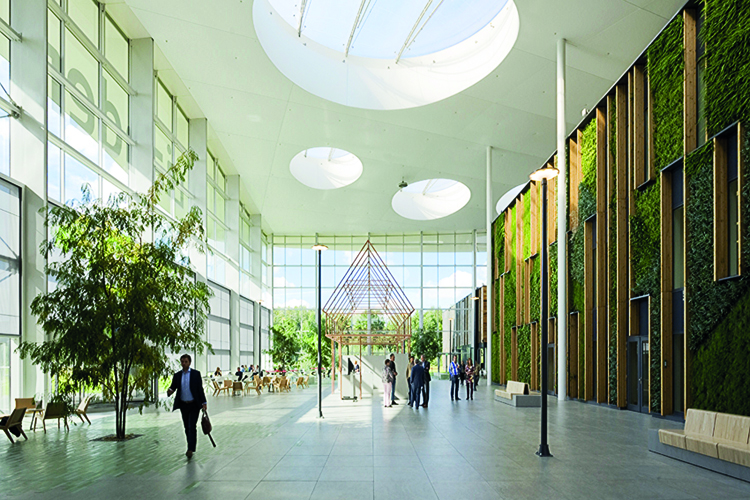 |
|
Internal view of Liander’s new building, Dulven.
|
The future lies, thus, in service, not ownership?
Rau: “That is exactly it. Use, instead of ownership, can work in every sector where what we call limited editions are required. We are convinced that once producers keep ownership of their products and regard their installed base as a depot for parts and materials for the future they will start producing in a different way.
“Planet Earth is a closed system. All that is physical in a closed system is a limited edition in essence, and, thus, it has a value. We have limited materials and it is service, not ownership, that facilitates the way we use them in an unlimited way. If we really want to change the world, we must change business models.”
What changes for companies that adopt a business model based on the product as a service?
Rau: “The producing company continues to hold ownership of and responsibility for the product that is used as a service and regards it as a materials depot. Remaining the owner, the producer understands that by creating low quality objects, they get low quality objects back; while creating good quality objects, after a period of time they get good quality objects back. Objects which can be reused either integrally or in parts.”
What is the next step for closing the circle?
Rau: “I do not think this is about closing the circle. This is a misinterpretation. Closing the circle means that we are still optimising material flows in the chains we have organised. The next step is the ‘continuous material chain,’ that we have devised as an alternative to closing the circle. The central element is that the materials are always present at the front and back of the chain. They never get lost.”
Oberhuber: “Closing the circle is just one of the options. We need to think about multiple circles. The smallest loops would be loops in which products are repaired and refurbished, but you can also look at the reuse of components in the bigger material loops. The components or materials can go back to the initial producer or they can even go to other producers. There are components that cannot go back into a computer, but could work perfectly in a light bulb or in another device. It does not matter who will use the material afterwards. When it comes back, it may be used by a different company than the previous one.”
What are the main obstacles at this stage and how can we drive this transformation in countries and companies, which do not yet see this opportunity?
Rau: “The main obstacle lies between our ears... We overcome the mental obstacle by showing the financial incentive for the transformation. Approaching the problem from a moral point of view does not work. By making the financial benefits visible, we can move beyond companies’ fear of the new system. I would begin with high-level brands. In Italy, I’d start with Ferrari whose business model has always been based on the ‘limited edition,’ but it has nothing to do with the environment. Companies must continue with their traditional business and, in parallel, begin a new business, starting small, with low risk, trying, gaining confidence and expanding bit by bit.”
Oberhuber: “Most of the large producers, are highly dependent on raw/virgin materials. They run the great risk that these materials will finish, while the new system has less risk. A manufacturer who maintains ownership over the materials knows which ones will come back as well as when and how much. This does not mean that the producers must manage the take back phase on their own. The important thing is for them to facilitate the process under their own responsibility.”
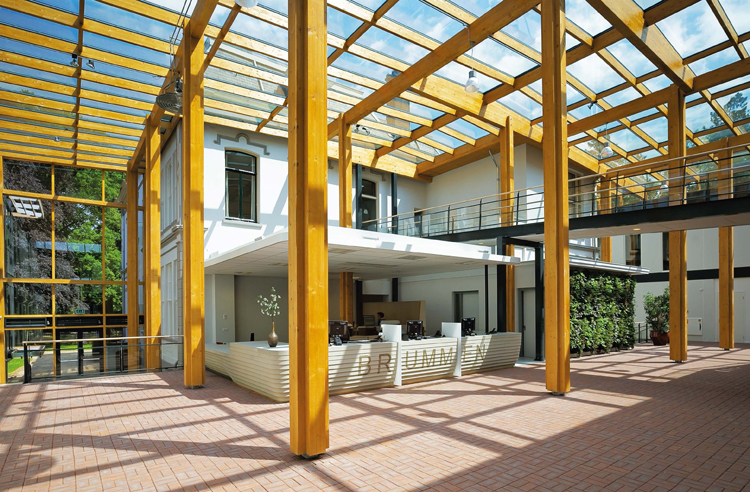 |
|
Interior of Brummen’s Town Hall.
|
Do we not lose competition between companies that way?
Rau: “Competition no longer has anything to do with materials. In the German automobile sector, for example, Volkswagen, Audi, Mercedes and BMW have developed a platform together with a sole budget for researching materials. When the materials come back, Mercedes could give them to Audi if they do not need them anymore. New marketplaces between producers could be created. With the advantage that everything could become cheaper because companies, that today only trade materials, without creating any value, will thus be cut out.”
So will logistics change too?
Oberhuber: “Yes, I believe there will be nearby repair centres and more centralised production centres. 3D printing will play an important role, by realising only the missing parts needed to repair the product.”
What will the house of the future be like?
Rau: “I imagine something halfway between a hotel and an owned home. There are things in homes, which we are not attached to, such as electronic devices, therefore we do not need to own them, we get the as a service. But there are also special objects, maybe a memory of grandparents, which we want to preserve, these are objects which you want to own and pass on to your own children. Ownership means not only having power over an object, but also being responsible for it. The responsibility of owning an object, in a closed system with limited resources, is immense and people must be aware of this.”
In this context, is there currently a player missing?
Rau: “Yes, the Dutch government, that should be defining the framework of reference for organising the circular economy and it is yet to do it.”
What can the government do in practice?
Rau: “Not give any building permits except for energy neutral or energy positive buildings, like in Switzerland. Tax resources more and tax labour less as it is an unlimited resource.”
Oberhuber: “The government can promote repairing objects like in Sweden. It can, for example, set a maximum limit for the cost of repairing a product rather than getting a new one. There are a lot of incentives that could be activated. Companies will move as a consequence, once the objectives have been established.”
What message do you have for companies that have not yet begun their journey towards the circular economy?
Oberhuber: “Companies that do not change quickly enough will soon be left behind. They must change otherwise there will be a moment where they will have no access to the materials they need to continue to produce. This demands not only an operational but a deep cultural transformation, all processes need to be revised: design, production, business models, finance, everything.”
Rau: “This is already the present and it will be the future. The planet is not waiting. It is following its own laws. We must decide if we are going to take part in this process or just observe. We must become ‘mental farmers:’ a farmer’s knows everything about plants, animals, clouds, the weather, water, and the rain, and he is planning ahead, long term in multiple cycles as he has to deal with the consequences of his own decisions. We must mentally become farmers, but in an immaterial way as we have no land to deal with. We must be aware that there will be consequences to our actions and these will affect the planet and the limited resources we have available to us.”
What role do investors have? Who will be investing in this transition?
Rau: “The negative interest in current capital means that there is too much capital in circulation. The transition is not a money problem.”
Oberhuber: “Pension funds are very interested in this circular transition because they are looking for sustainable long-term investments which are difficult to find these days.”
Madaster, www.madaster.info


